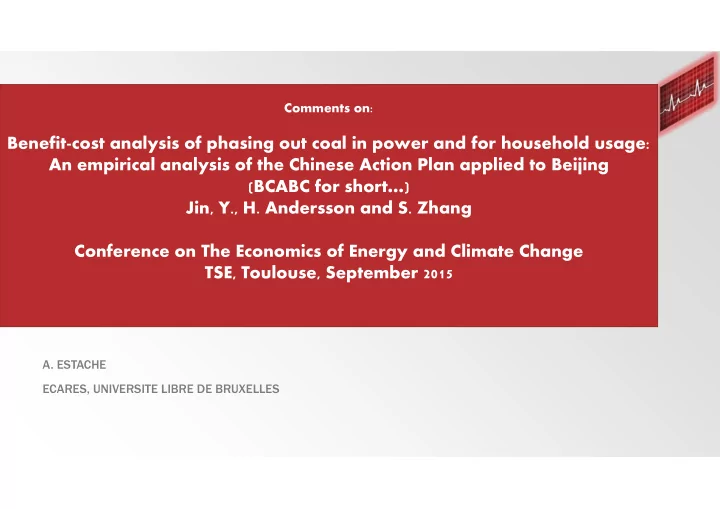

Comments on: Benefit-cost analysis of phasing out coal in power and for household usage: An empirical analysis of the Chinese Action Plan applied to Beijing (BCABC for short…) Jin, Y., H. Andersson and S. Zhang Conference on The Economics of Energy and Climate Change TSE, Toulouse, September 2015 A. ESTACHE ECARES, UNIVERSITE LIBRE DE BRUXELLES
The big picture (1) ▪ The title is long…but states the purpose clearly: …a CBA ▪ with 2 sectoral focuses ▪ energy production and household energy consumption ▪ with 2 environmental focuses ▪ ambient AND indoor air pollution ▪ with 2 main technological approaches ▪ cleaner production and consumption processes ▪ with 2 outcome focuses: ▪ air quality and heath effects ▪ But…with a single regional focus ▪ 1 of 3 regions (Beijing) for which a coal consumption cap to be reached by 2017 has been imposed through a 2013 National Action Plan
The big picture (2) ▪ Main conclusion is just as clear ▪ Net social benefit from households consumption technology change ▪ Net social cost from replacement of coal plants by gas plants ▪ Total payoff is unlikely to meet expectations and policy needs to be tightened ▪ But there is a lot more going on (maybe a bit too much to keep track of it all…) ▪ Advocacy “side shows” since argue for: ▪ Adoption of CBA and impact assessment for policy evaluation in China ▪ A more explicit focus on HH coal consumption and indoor air pollution ▪ A diversification of technological and policy solutions to be considered, including local options ▪ A re-focus of policy goals on health & welfare outcomes rather than on only emission levels and technology.
Comments on Methodology (1) ( its discussion covering about a third of the paper…) ▪ Paper really delivers actually 2 CBA: ▪ (1) phasing out and replacement of coal fired power plants by gas fired ones ▪ (2) substitution of the equivalent amount of coal used in HH by clear fuels and/or reconstructions ▪ Useful unusual feature ▪ Local authorities can pick technology to achieve coal reduction target ▪ Authors use this to compare Social Net Benef for a given cut across sectors ▪ i.e. the “net cost effectiveness” of achieving a comparable goal
Comments on Methodology (2) ▪ Approach: ▪ Pick a representative power plant consuming 600K tons annually of coal ▪ …NO INFORMATION ON TECHNO, AGE, … ▪ Yet reasonable to assume some heterogeneity along all these criteria it seems ▪ Some of this comes out in the Monte Carlo but not really detailed enough ▪ Equivalent for HH is 200,000 HH consuming 3 tons annually (=600K…) ▪ Easy to think through but a bit odd to get a clear sense without some normalization to population concerned ▪ Focus on health and environmental benefits in each sector ▪ Useful and best practice ▪ Some concerns with risk of double counting…but maybe bcse I did not fully understand some of the details ▪ Are health benefits and aesthetics gains not already part of the environmental benefits? ▪ Cost are quite detailed (opex, capex, and incremental fuel costs) ▪ …but may too standardized in a country in which investment has been FAST and hence technological progress has been quite strong within the industry (efficiency stories) ▪ Monte Carlo to deal with uncertainty ▪ All values in 2011 US$
Comments on Methodology (3) ▪ Scenarii ▪ Simple for power plants ▪ with somewhat odd assumption on price of gas vs coal ▪ (controlled vs mkt based) ▪ Various options for HH with somewhat complex CBA ▪ Thermal isolation, electricity heating stove rather than coal ▪ Adjusting HH vs non-adjusting HH ▪ full use HH gets full health benefit and generate max environmental benefits ▪ Ignores learning costs
Big picture – Part 2 ▪ Solid CBA anchored in well tested evaluation methods for both costs and benefits ▪ Solid policy implications ▪ Which do raise some concerns not just for China ▪ Some more issues however…
Issues (1) ▪ Key interactions may have been left out by choice of method ▪ CGEs are now quite popular to look into these interactions across product and labor markets that result from changes linked to climate change concerns built in energy policies… ▪ Most of the time, these effects impact for economic costs and benefits in unsuspected ways ▪ Think of interactions through labor market and education ▪ Differences across Chinese regions for instance is a realistic concern ▪ would at least argue for a replication of this paper to other regions ▪ Discount rate choice and meaning ▪ Historical Opex and Capex heterogeneity in costs ▪ this means expenditure timing more than standardized CBA NPV computation would imply ▪ No recognition of learning by doing which has really been quite impressive in China ▪ Which is related to me earlier comment on relevance of the multiplicity of technologies which overlap…not picked up by model firms/HH
Issues (2) ▪ No clear sense of lower and upper bound (or of confidence interval for results) ▪ Even with Monte Carlo ▪ No clear discussion of various incentives designs to stimulate behavioral change ▪ i.e. Adopting vs non-adopting HH ▪ Editorial: ▪ Too many details on earlier studies ▪ Biblio a bit odd…
Overall ▪ Really useful paper at the policy level ▪ In particular in the current context of global negotiations pointing towards the fast growing emerging economies as key players in the CC debates ▪ As is it would work as a policy report ▪ For an academic publication… ▪ may need some shrinking… ▪ And a fuller discussion of some of the limitations ▪ Including some reflected in the comments
Recommend
More recommend